Drawing is such a beautiful hobby.
And a lot of people think drawing is easy in the beginning.
But when they start drawing, they realize that there is a steep learning curve at first.
This makes them get discouraged and they may even give up drawing because they feel like they’re just not good enough.
But drawing mistakes are really common, and everybody makes them.
So if you avoid some inevitable drawing mistakes, you’ll find that your drawing skills will improve rather quickly!
This will keep you motivated to stick with drawing.
What you need to keep in mind is that a lot of beginner artists and even intermediate artists make these drawing mistakes.
I’ve been drawing since I was three, so I’ve made most of these mistakes!
So, in this post, I’m going to cover the most common drawing mistakes and also guide you to fix those drawing mistakes so that you can become a better artist!
Let’s dive in!
This post includes affiliate links. If you do decide to purchase something, I will make a commission at no extra cost to you. For more information, please read my entire Privacy Policy here.
Table of Contents
13 Common Drawing Mistakes most Beginner Artists make + How to Fix them!
1. Not using references to draw
When you are just beginning to draw, you need to study subjects in order to draw them.
You cannot draw from imagination until you learn human anatomy because you need to know the rules in order to break them.
The same goes for nature, learning to draw expressions, etc.
References are essential.
At the same time, you should not copy an image entirely. It isn’t ethical and you can get sued by the artist.
It is important to study several pictures and observe them instead of blatantly copying them.
This is how you will slowly develop the skill of drawing from your imagination.
You can use multiple reference pictures to make a picture.
This will help you learn faster!
For instance, you can use 1 reference picture to draw a pose, another for the expression of the person, another for the hairstyle of the person, and yet another photo for color inspiration.
Combining multiple reference pictures will help you develop your observational skills as well!
2. Not paying attention to color theory
First of all, let’s understand what color theory is.
Color theory is the science and art of using color.
Color theory explains how human beings perceive color; and the visual effects of how to mix colors, match them or contrast colors.
Whether you are painting, coloring, or even using digital art, you need to understand and practice color theory in order to color your art so that it is pleasing to the eye.
I had no idea about color theory when I first started illustrating and this resulted in me using extremely harsh and bright colors to get my point across.
Here’s an example:
However, with time and enough learning (I used this course to understand color theory), I was able to color my illustrations and get my story across more effectively.
Color theory is also crucial because you can tell a story with your colors.
If you use a lot of grays and blues, you can convey sadness and misery. And Disney and Pixar and well known for using colors to tell stories.
So, pay attention to the colors you use. It’s extremely important and you should not skip this.
Here are some books to help you with this:
- Interaction of Color: 50th Anniversary Edition
- Color Theory: An essential guide to color from basic principles to practical applications (Artist’s Library)
Additionally, you can take this beautiful and inexpensive online course by Jean Fraise to understand what color theory is and how you can apply it to your images. I found it incredibly valuable!
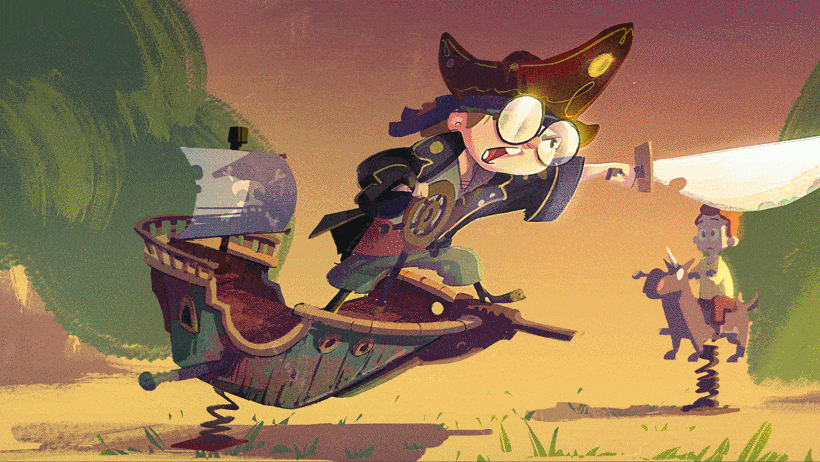
3. Getting addicted to Perfectionism
Unfortunately, you cannot be perfect when you’re just starting.
When you are learning to draw, no drawing will come out perfect no matter how hard you try because you are learning the art and the learning curve is steep.
Remember that.
If you get bogged down by creating the perfect piece, you are never going to finish the piece.
It is important to first build a daily habit of drawing every single day so that you become consistent and improve your drawing skills.
Your aim should be to get as many pieces finished as possible so that you can develop your drawing techniques.
You have to get through drawing 1000 pieces of garbage before you start drawing the good stuff.
That’s just how it goes.
So quit perfectionism and just draw!
Embrace the process of making mistakes. The faster you fail and get through those failures, the faster you will learn to draw.
Remember that progress is better than perfection.
4. Not training your hand enough

One of the biggest drawing mistakes I see people making is not spending enough time training their hands.
Your hands need to be very fluid when drawing.
When you are a beginner, your hand will take time to get adjusted to making strokes or drawing in fluid motions.
You need to train your fingers and wrists so that it creates exactly what is in your mind.
In the beginning, you will find a significant mismatch between the stroke you intend to draw and the stroke that ends up happening on the paper.
This is normal.
Keep practicing daily, and you’ll notice that it gets more accurate with time and practice.
Another thing to keep in mind is to loosen your grip on your tools. You cannot hold the pencil using a lot of pressure because this will cause very sharp and dark lines.
You have to hold the pencil loose enough so that you can make long, flowy lines and this will make your drawings look more organic.
When you want to draw a long stroke, you need to grip the pencil far away from the point. This will help you move the pencil in a nice, long stroke.
For shorter strokes, you can grip the pencil closer to the point.
All these adjustments come with practice. You can also watch YouTube videos or do some drawing exercises to get better at this!
5. Not understanding the overall structure before you start shading/coloring
Do not start drawing the complete picture when attempting to sketch something.
Take some time to study the object first.
Do a rough outline of the entire image first with very light pencil strokes.
Understand the overall object you are trying to draw.
And slowly draw the outline.
If you do not get the outline or the shapes right, no amount of drawing, shading, or coloring is going to fix your drawing.
Keep this in mind.
So, take your time to understand the overall structure of the image before you start drawing it.
This comes with practice.
At one point in time breaking an object into shapes will come naturally to you. As you develop your drawing skills, you will get better at this!
You should never draw hard lines in any piece of art, always build up to dark lines by slowly drawing over the lines.
Focus on the overall structure, then the shapes that comprise the structure, and finally you must get down to the details of the picture.
The detailing always comes last!
Spend some time learning perspectives to understand how to observe objects and draw them as accurately as you can.
If you find that your backgrounds look odd or your city view looks flat, then there is a problem with your perspective.
Here are two books I highly recommend checking out so that you can improve your drawing perspective:
6. Using cheap art supplies
You cannot make good art if you are using cheap drawing supplies.
When creating art, it is crucial to use good quality (not necessarily expensive) drawing supplies.
This will help you get accustomed to good and standard drawing tools, and you’ll be able to draw with ease.
I also suggest that you do not get the most expensive drawing tools because you will be too afraid to use it for fear of ruining it.
So, get something moderately expensive – something that is considered good.
Figure out what you are using every day to draw. Drawing involves a lot of experimentation.
Once you understand what tools you are comfortable using, go online and try to find some proper drawing tools that have good reviews.
For instance, I don’t use anything other than the Staedtler Mars Lumograph Pencils when it comes to pencil sketching. They aren’t that expensive, but they are one of the best tools for pencil sketches.
I’ve used so many other pencils, and I’ve been disappointed with the results.
Crappy tools equal crappy drawings.
And it sucks to put in so much time drawing and then get a subpar drawing.
So, use good quality tools.
Here are some of my recommendations:
7. Not paying enough attention to the background
I’ve been guilty of this way too many times to count.
It’s so easy to get lost in paying attention to the main character, that we feel drained to do the background once the character is finished.
It’s pretty natural.
But backgrounds tell a story. They add depth to our drawings.
Once I started paying attention to backgrounds, my eBooks looked more natural and aesthetic.
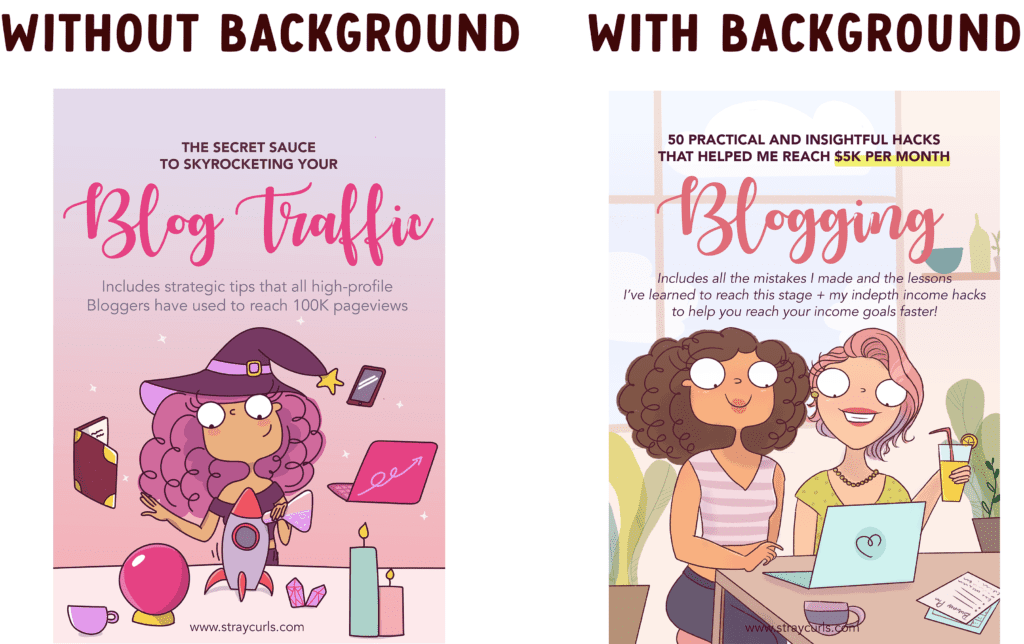
Even if you’re drawing a simple background, give the background some of your attention and time. It will complete your drawing and make it look more wholesome.
Also, it’s very easy to tell the difference between an amateur artist and an expert artist just by looking at the backgrounds of their art.
Expert artists will give the same amount of attention to detail with their backgrounds as the forefront objects.
So, think a bit about your background when drawing your art.
8. Not paying attention to the light source
How do we even see objects?
We see because the light reflects off objects and enters our eyes. Light is what helps us see.
So when we look at an object, some areas are going to be light and some are going to be dark depending on where the light source is.
This is very important when you are drawing anything!
So, before you start drawing, pay attention to the light source.
Figure out how many light sources are there, what is the direct light source, and where exactly is the ambient light.

Once you are able to differentiate which parts of the object are hit with the direct light and which parts are being hit by reflected light, your understanding of light will get better and your drawings will look more realistic and real.
9. Not getting the proportions right
Have you ever tried drawing realistically and then found out that you’ve drawn one eye bigger than the other?
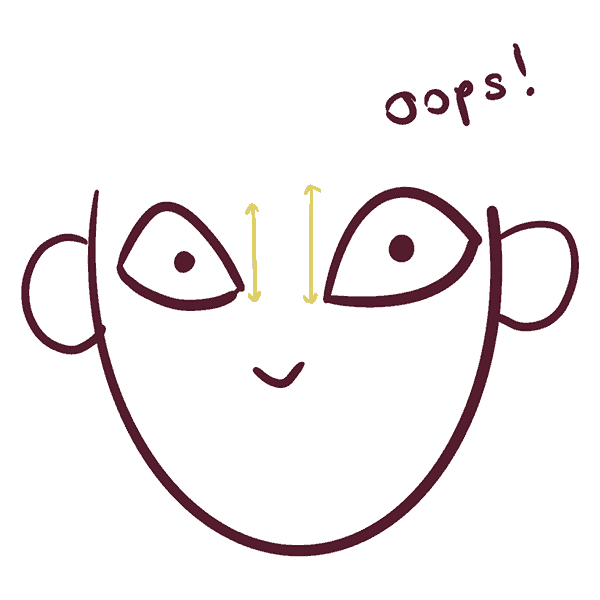
This is because you’ve got the proportions wrong.
Don’t fret. Most artists take some time to conquer this drawing mistake and start drawing things proportionately with reasonable accuracy.
The best way to remedy this is to thoroughly observe your object and then draw an outline before breaking it into rough shapes.
Never start drawing the details first.
This will result in wrong proportions.
Here are a few methods you can use to get your drawing proportions right.
10. Not experimenting enough
When you first start drawing, it can be very tempting to niche down.
But don’t do this.
Experiment with drawing everything first so that you get some experience drawing objects, people, space, and nature before you discover what makes your heart sing.
This is important if you want to know for sure what you really like drawing.
The key is to experiment with drawing various things using various mediums before you figure out what you really enjoy drawing.
Practice with pencils and paint.
Feel free to practice with traditional and digital art.
Just keep drawing and let your imagination flow wild when you are using different mediums. Every artist has a preference for the drawing tools they use.
11. Not drawing consistently
You cannot get better at drawing if you draw for 1 day and then stop for a week.
Drawing requires consistent practice.
And the only way to get better at drawing is to be committed to the art (pun intended).
So, create a schedule and stick to it.
Focus on building a habit first – try to draw every day for 15-30 minutes. When you feel you are committed to that, increase the time duration to an hour and move upwards from there.
This is how you build a nice drawing habit.
Doing just this much will help you become a better artist.
Please remember that you cannot wait for inspiration to hit you to draw.
That’s not how it works.
Most of us artists draw every day whether or not we feel inspired.
Once you start working in this field, you will have to sit and draw whether or not you feel like it. You may also have to draw outside of your comfort zone.
So building a daily drawing habit will help you build that drawing regime you require.
12. Not sitting in the correct posture
If you love drawing and want to become a full-time artist, chances are you will be drawing for hours in a day every day.
Your drawing posture might not matter much to you now, but eventually, your bad posture will affect your health and cause a lot of pain.
I purchased this beautiful book that talks explicitly about drawing postures and exercises for artists. I also recommend buying this posture brace for your back when you’re sitting and drawing.
You need to maintain a good posture while drawing so that you can draw for long hours and not screw up your back and physical health.
You do not want to have joint or muscle pain as you grow older – it is only going to make things so much worse for you.
Please take 5-10 minute breaks every 45 minutes.
Do stretches and take a walk to the kitchen and back. Get yourself a glass of water and keep yourself hydrated while you draw.
13. Comparing your journey to other people
Please note that there is no such thing as artistic talent.
It’s a myth.
People are born with varying desires to draw; some might be more passionate than others. That is the only thing you can actually measure.
When it comes to drawing, you need to develop your skills just like everyone else.
Some people might pick up drawing more easily than others, but that really depends on how much time they spend drawing and how observant they are.
There is nothing you cannot do.
So, do not be discouraged if you see other people drawing better than you. This is one of the biggest drawing mistakes I see artists make – comparing their art to others.
Use it as inspiration – if they can draw it so you can you!
And aim to get better.
Focus on your own journey and compare your art to your own every 3-6 months.
Analyzing your own progress will help you become a better artist.
Frequently Asked Questions – Drawing Mistakes
How can I draw better?
The only way to draw better is to draw consistently and build a daily habit of drawing.
Drawing every day will not only help you build a habit but also improve and sharpen your skills as an artist.
You can read this post to learn how long it takes to learn to draw.
Another thing to note is to constantly keep learning.
Your learning is never finished as an Artist.
You have to keep improving the areas you feel need more refinement.
For instance:
- Learning human anatomy
- Understanding light and how to capture light in your art
- Improving your color theory
- Becoming better at understanding perspectives
There are so many areas you can train in to help become better at drawing.
Is drawing talent or skill?
Drawing is a skill.
Nobody is born talented at drawing.
It is a skill that is learned via practice.
Like music, you need to train your brain, eyes, and hands to become better at observing and drawing.
It is a beautiful hobby that anybody can pick up drawing at any age.
Conclusion
I hope this post helped you understand what drawing mistakes you are making and how to remedy them.
If you have any questions regarding drawing or feel there are more drawing mistakes I should cover, please leave a comment below.
I will be more than happy to help you or point you to a fabulous resource!
Here are a couple of resources that helped me learn more about drawing and building a career out of it:
Books that helped me learn more about drawing:
- How to Draw Anime ( Includes How to Draw Manga, Chibi, Body, Cartoon Faces )
- Making Comics: Storytelling Secrets of Comics, Manga, and Graphic Novels
- Sketch Every Day: 100+ simple drawing exercises from Simone Grünewald
- Figure Drawing: Design and Invention
Books that taught me how to make money with my art:
- Draw What You Love: The Art of Simone Grünewald
- Becoming a Successful Illustrator
- Graphic Artists Guild Handbook, 16th Edition: Pricing & Ethical Guidelines
- Art, Inc.: The Essential Guide for Building Your Career as an Artist
Courses that helped me create better art digitally and gave me wonderful business ideas:
- Procreate for Beginners: Digital Illustration 101
- Drawing for beginners
- Female Cartoon Character Design with Procreate
- Creating comics for Instagram
Here are some posts you will enjoy:
- The ultimate guide to finding your art style
- Is digital art easy? Read the pros and cons of traditional vs. digital art
- Why do people love drawing? Drawing Benefits you should know!
- How long does it take to learn how to draw? From newbie to pro!
- How to become a full-time artist without a degree
- 13 signs you are meant to be an artist
- 10 fun drawing gifts to give children below the age of 10
- 13 easy ways to make money online as an artist
- 9 best drawing books for beginners
- How to draw without a reference
If you enjoyed this post, please subscribe to my email list so you can get free drawing tutorials weekly!


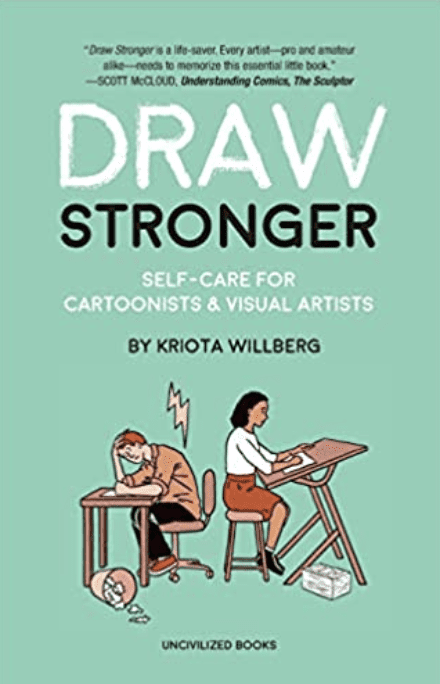


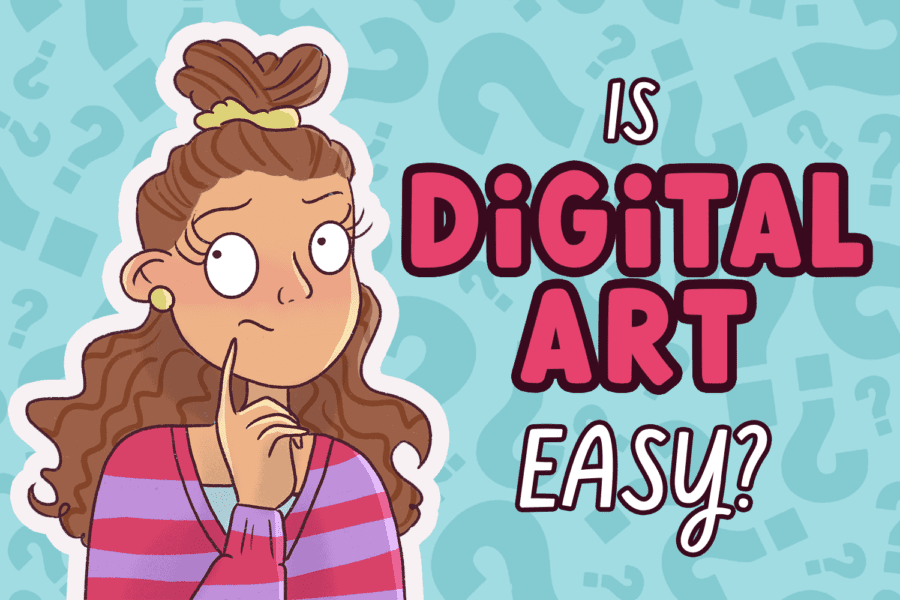

Leave a Comment